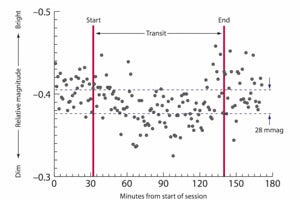Astronomy is no stranger to citizen scientists. Amateur stargazers are credited with the discovery of comets, asteroids, and even planets. That said, while amateurs don’t use multi-million dollar observatories, it’s still an expensive hobby. Or rather, it was—modern tech, it would seem, is taking homebrew astronomy to new heights.
How high? Off-the-shelf gear assembled at home for under $500 (used) can observe an object 370 trillion miles from Earth. David Schneider recently detected a planet orbiting a star 63 light years away using naught but a hinged plywood base, a stepper motor, some gears from an inkjet printer, an arduino microprocessor, and a digital camera (with telephoto lens).
The planet, HD 189733 b, was discovered in 2005. Its tight orbit and large mass make it an exoplanet type known as a ‘hot Jupiter’. Many early exoplanet discoveries were like HD 189733 b because their gravitational and light curve effects were more obvious than similar effects from smaller worlds orbiting at greater distances. HD 189733 b is the nearest known hot Jupiter to Earth. Together, these characteristics made the planet an ideal candidate for Schneider’s project.
His first challenge was building a star tracker to keep the camera trained on the target star system (as it moved with Earth’s rotation) for long exposures. That’s where the arduino, motor, and barndoor base came in. “Aligning the hinge to your hemisphere’s celestial pole allows you to track a star as the plywood “doors” separate at a constant rate,” Schneider writes.
The next challenge was getting the star, not visible to the naked eye, into the camera’s field of view. Schneider used a $20 viewfinder and waypoints, like the Dumbbell Nebula, to locate the system. Then using software that came with his camera, he took a series of automated exposures (50 seconds each) of the star.

The most challenging task according to Schneider was figuring out when the planet would pass between Earth and its parent star. The event, known as a transit, is like a solar eclipse when the moon moves between the Earth and sun. The detection method Schneider used works on the same principle. During a planetary transit, the parent star dims a little.
It was this dimming that Schneider’s jury-rigged gear detected. You can understand how this might make an amateur tinkerer very happy.
“So it seems my home-brew observatory did detect an exoplanet—using little more than a run-of-the-mill DSLR and a $92 eBay camera lens!”
Schneider is not the first amateur to detect an exoplanet. Amateurs have been using sensitive CCD cameras to detect alien worlds since 2000. But since then, the cost of gear capable of such a feat has declined substantially.
No doubt this is a great example of the increasing power and decreasing cost of digital technology. But there’s something else too—it means we can do more science than before.
Though it still takes state-of-the-art astronomical observatories to discover (and even directly image) most exoplanets, telescope time is precious. Once discovered, amateur astronomers can fill in missing information for a more complete picture of the planet. One project even farms out data from the Kepler space telescope to amateurs who comb it for planets.
With the power of the crowd and modern digital devices, it’s clear—you don’t need a billion dollars to do big science.
Image Credit: Shutterstock.com; David Schneider/IEEE Spectrum/YouTube



